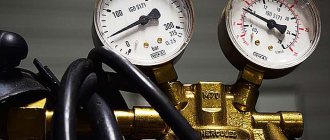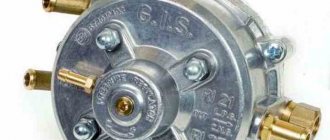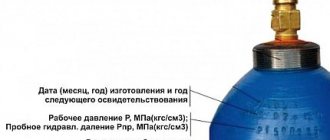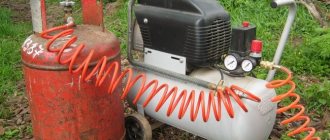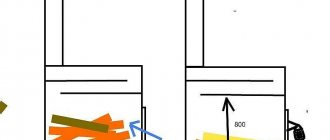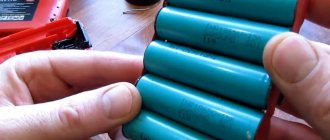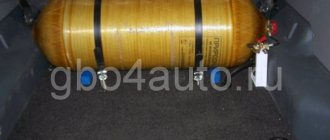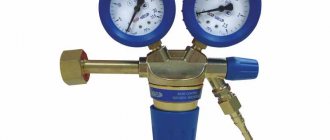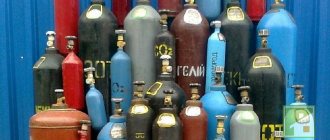Cylinders are universal equipment for storing and transporting gaseous substances for domestic and industrial purposes.
The shut-off valves in them do not last forever, so over time the valve on the gas cylinder will need to be replaced, which you can do yourself in compliance with a number of safety rules.
- Method 1: Attaching the limit bar
Components of a gas cylinder
Requirements for production processes and technical characteristics of gas cylinders are regulated by rather old GOSTs 949-73 and 15860-84.
The maximum operating pressure in the devices ranges from 1.6 MPa to 19.6 MPa, and the wall thickness can vary from 1.5 to 8.9 mm.
The protective cap on gas cylinders can be screwed onto a special neck thread, completely closing the valve, or it can be welded to the body and only protect the valve from accidental external impacts.
A standard gas cylinder assembly consists of the following elements:
- Cylinder body.
- Valve with shut-off valves.
- Valve closing cap.
- Backing rings for fixation and transportation.
- Support shoe.
An important element of the cylinder is also the technical information stamped on it.
The information stamped on the cylinder is used by service centers when refueling and re-inspecting equipment, so you should not paint it heavily
The bottom of the cylinders is shaped like a hemisphere for uniform distribution of internal pressure. For better stability of the body, a shoe is welded on the outside, on the lower edges of which there are often holes for attaching the cylinder to horizontal surfaces.
Types and design of valves
The threads of valves for gas cylinders are standardized, but they themselves can have a variety of designs. The choice of valve model is influenced by the type of chemical substance being stored, production features of operation and the amount of money. Before purchasing new equipment, you should familiarize yourself with the design options and internal structure of the valves.
Classification of shut-off valves for cylinders
The design features of gas cylinder valves are determined not by the whims of engineers, but by safety considerations.
Gas valve model VB-2. This valve model has proven itself positively back in Soviet times. It has been used in everyday life and industry for decades, causing a minimum of problems.
Depending on the material used, shut-off valves are divided into:
- brass;
- steel.
The choice of metal for the manufacture of the valve body is determined by the type of gases contained in the cylinder. There are the following types of shut-off valves, depending on the type of chemicals stored:
- Acetylene. The body of such cylinders is painted white. Special valves are used in cylinders containing acetylene, chlorine, ammonia and other aggressive substances.
- Oxygen . The cylinders are painted blue and are intended for storing oxygen, argon, hydrogen, nitrogen, carbon dioxide and other inert gases.
- Propane-butane . They are painted red and are intended for storing substances corresponding to the name and other gaseous hydrocarbons. The most common valve type model for such a cylinder is VB-2.
Valves for acetylene cylinders are not made of brass because the substances they contain may react chemically with copper. Typically, carbon or alloy steel is used to manufacture shut-off valves of this type.
Gas valve device
A standard gas valve has the form of a tee, each fitting of which has an external thread. More advanced models may have an additional protrusion - a safety valve. Its purpose is to relieve excess pressure in the event of a full cylinder heating up or in case of incorrect filling.
The lower fitting of the valve is used to connect to the gas cylinder, the upper one is used to attach the flywheel, and the side one is used to connect communications for gas outlet and injection. The valve design for a gas cylinder is quite simple. Shut-off valves usually consist of the following general elements:
- Brass or steel body.
- A stuffing box valve or flywheel connected to the body with a union nut.
- Internal locking mechanism with valve and stem.
- Sealing gaskets.
- Plug for the outlet.
You can look at the design of valves on gas cylinders of each type in more detail in the presented images.
Image gallery
Photo from
The release of poisonous gases through a safety valve can be harmful to health even in open spaces
Acetylene valves use maximum seals to prevent toxic gases from getting out.
The gaskets in such a valve should not be made of pure rubber, because it can interact with oxygen
The seals on propane cylinders are simple, so they must withstand a maximum pressure of only 16 atmospheres
Valve with safety valve
Valve for acetylene cylinder
Valve for oxygen cylinder
Valve for propane-butane cylinder
Worn valves can leak small amounts of gas, which can lead to unpredictable consequences in enclosed spaces. To prevent such situations, a plug is used on the side fitting, which serves for additional sealing of the cylinder during transportation and long-term storage.
The direction of the threads on the outlet holes depends on the chemicals contained in the cylinders: the right is used for non-flammable gases (oxygen, nitrogen, argon, etc.), and the left is used for flammable gases (hydrogen, acetylene, propane, etc.)
The principle of operation of the assembled gas valve is unremarkable. To supply gas and shut it off, simply slowly turn the flywheel in the appropriate direction.
Types of cylinders
Products are distinguished by type of filler:
- for compressed and liquefied gases;
- oxygen;
- acetylene;
- containing propane-butane.
There are different types of cylinders depending on the type of gas in it.
To transport compressed and liquefied gases, steel cylindrical vessels with a volume of 0.4 to 55 dm3, with a conical hole in the neck with a thread, are used. It is into this hole that the balloon shut-off valve is screwed into. The valve design is different for each gas, so that oxygen valves do not screw into cylinders with another gas.
To install the valve, you need to fit a male threaded ring onto the safety cap neck. The safety cap protects the cylinder valve from impacts during transportation.
Mandatory Precautions
Before replacing the gas cylinder valve, precautions must be taken. Work must be carried out in such a way as to protect people from potential hazards and keep the equipment in working condition.
The following precautions are used when preparing to replace a gas valve:
- The remaining contents of the cylinder can only be vented in an open space. An exception can be made only for nitrogen, air and argon.
- The work area should be well ventilated, although it is advisable to carry out work outside.
- There should only be one closed gas cylinder within the workplace.
- The flywheel must be unscrewed slowly to prevent electrification.
- You can begin replacing the valve only after the pressure in the cylinder and outside has been completely equalized.
When screwing the valve into the cylinder, fum tape or special lubricants are used, which provide increased tightness and strength of the connection. When replacing a faucet, such seals greatly complicate the process of dismantling it. To solve this problem, you can heat the valve with a hairdryer.
There is no need to save on gas fum tape, because high-quality material will eliminate the need to twist the valve due to gas leaks
You can heat the shut-off valves only after bleeding the gas from the cylinder and closing the tap. In this case, the procedure is safe and will not lead to unpredictable situations.
An alternative to a hairdryer is to wrap a cloth around the valve and then pour boiling water over it. With this heating method, any suitable plug should be screwed onto the outlet fitting to prevent water from entering there.
After taking all precautions and warming up the shut-off valves, you can begin to unscrew the valve, which can be a difficult task at home.
Safety regulations
Valves are the most vulnerable in gas cylinders, so you need to treat them correctly to prolong their service life. New valves must be stored or transported with plastic plugs. They prevent damage to the threads. If the coils are jammed, it will be difficult or impossible to install the valve in the cylinder. Likewise with the thread for the gearbox.
When a cylinder with a valve is transported, a plastic or steel cap is placed on top. It protects the valve from shock if the gas tank is dropped. Otherwise, the valve may break off and the balloon will become a rocket driven by internal outgoing pressure.
When carrying oxygen, carbon dioxide and acetylene cylinders, two people are allowed to hold the valve with their hands, but this is inconvenient. The faceted square part or the handwheel may press on your hand and cause the valve to slip out, causing it to hit the ground or floor. It is better to use special carts when transporting cylinders around the workshop, enterprise territory, or warehouse. For long-distance transportation of cylinders, special racks are used, where the vessels are secured with belts or chains to prevent them from falling.
Handling oxygen cylinders requires clean hands. Do not unscrew or tighten the valve with gloves in oil, otherwise an explosion will occur. Do not accidentally drop drops of oil or oily things onto the valve or the cylinder itself.
Screwing in new shut-off valves
Before tightening the valve, all connected parts must be degreased to prevent clogging of the locking mechanism. To do this, you can use a cloth with regular detergent or moistened with white alcohol. After this, rinse the surfaces with plain water and allow them to dry.
A new valve is never screwed to a cylinder with bare threads. It is imperative to use a sealant: special thread compound or fluoroplastic fum tape. They are applied to the lower fitting and only after that the valve is tightened.
No additional gaskets are expected to be used between the valve and the cylinder body; a seal and appropriate clamping force will suffice
The thickness of the gas fum tape is greater than sanitary tape and is 0.1 - 0.25 mm, and its reel should be yellow. The tape is wound with tension in 3-4 layers. It is better to twist it once again when it breaks than to make the seal loose.
It is advisable to tighten the valve with a torque wrench. Steel shut-off valves are screwed with a maximum force of 480 Nm, and brass valves - 250 Nm. After clamping the valve, you can proceed to subsequent steps to test the tightness of the resulting connection.
Installation and replacement of valve on a gas cylinder
When starting to install a shut-off unit for a liquefied gas cylinder, you must remember that this element will operate under high pressure conditions. Therefore, all work on installing or replacing such a unit should be carried out in strict accordance with the instructions.
Technically, changing the valve on a gas cylinder is quite easy - the outdated unit is simply unscrewed from the inlet hole in the container, like a regular fitting, and a new shut-off element is screwed into its place. What does the BC Melbet promo code give? Melbet promo code - gives a starting bonus upon registration of up to 10,500 rubles. Using the promotional code you can get: Sports bonus 100%. To receive a welcome bonus, you must top up your balance by at least 100, maximum by 19,500 rubles. The Melbet casino promotional code is entered when registering a new account. Thanks to it, you receive an increased bonus on your first deposit; the system adds 30% to the maximum amount. The standard bonus for the first deposit is 7,000 rubles, after entering the promotional code - 9,100 rubles. However, special precautions must be taken.
After all, we repeat, this unit is under pressure (for example, as much as 30 atmospheres of pressure are applied to the valve of an acetylene cylinder), therefore, the process of dismantling and installation itself should be organized according to the following scheme:
- At the very beginning, the valve shut-off unit should be moved to the “open” position. That is, unscrew it all the way to the uppermost position. As a result, the remaining contents of the cylinder will go either into the atmosphere or into some container.
- Once the cylinder is free of hazardous contents, you can begin to remove the valve body from the threaded hole in the top of the cylinder. For these purposes, you can use either a special tool or a regular adjustable wrench. It is necessary to understand that the valve was screwed in very tightly and, possibly, using a liquid sealant, therefore, before dismantling, the body of the shut-off element must be heated with a hair dryer.
- Having removed the old valve from the cylinder, you need to prepare a new shut-off unit for installation. That is, you just need to apply a gel or polymer seal to the conical fitting at the bottom of the body. As the latter, most often, ordinary FUP tape is used.
- After preparation, the valve is screwed into the hole on the cylinder body, first by hand, and then with a key. Moreover, as a key, it is best to use a special tool - a torque wrench, which allows you to adjust the tightening force. After all, for steel cases you need to create a torque of 480 Nm, and for brass - 250 Nm.
After completing the installation of the valve, you should put information about the date of the operation on the cylinder passport - a special plate mounted in the container body.
Safety precautions and installation quality control methods
Upon completion of the valve installation process, it is necessary to check the quality of the work performed.
To do this you need to do the following:
- A hose from the supercharger (compressor) is connected to the side fitting of the housing.
- The valve is moved to the “open” position and a portion of compressed air is pumped into the cylinder. After this, the cylinder valve is moved to the “closed” position.
- Next, a pressure gauge valve with a screwed-in measuring device (pressure gauge) is connected to the side fitting of the housing.
After this, the cylinder valve is moved to the open position and the same operation is performed with the pressure valve. As a result, the pressure in the system is displayed on the pressure gauge and, based on its fluctuations observed over a certain period of time, the degree of tightness of the cylinder-valve assembly is determined.
Of course, a hermetically mounted valve must maintain the pressure at the same level for a sufficiently long time.
Simplified control method
This technique is practiced in the field or in the absence of measuring instruments at hand.
To implement it you need to do the following:
- Compressed air is pumped into the cylinder and the valve is closed.
- Whipped soap foam is applied over the valve with a shaving brush.
- The tightness of the balloon-valve assembly is controlled by the absence of “bubbles” in the soap “cap” on the valve.
Despite its simplicity, this method is considered quite effective and is used by most pressure pipeline specialists.
Checking tightness and completing work
When checking the tightness of the valve connection, you will need to pump gas under pressure into the gas cylinder. This can be done in two ways:
- Pump gas using compressor equipment or a car pump.
- Connect two cylinders with a hose, the first of which is empty (tested), and the second is filled with gas.
First, under the control of a pressure gauge, you need to fill the test cylinder with gas with a pressure of 1.5-2 atmospheres. After this, soap foam is applied to the connection and the tap is opened slightly. If soap bubbles are not inflated anywhere, then the connection is sealed. But if even slight swelling of foam appears, you will have to re-tighten the valve.
When immersing the valve in water, it is advisable to close the side fitting with a plug so that water and suspended particles contained in it do not get into the locking mechanism
If the cylinder is small, then you can immerse its valve in a small bowl of water and see for bubbles.
After replacing the shut-off valves, the corresponding mark must be placed in the gas cylinder passport.
Guide to unscrewing the valve
An additional supply of tightness is never superfluous, but when replacing shut-off valves on a gas cylinder, the strength of its fastening can become a big problem. The difficulty lies in fixing the cylinder body so that it does not rotate when the valve is unscrewed with a key.
It is with this problem in mind that further step-by-step actions for replacing shut-off valves will be considered. There are many ways to secure the body of a gas cylinder; let’s look at some of them.
Method 1: Attaching the limit bar
You will need the following tools and materials: a pipe wrench, two bolts at least 20 mm long with two nuts and a metal corner profile at least a meter long. Instead of a corner, you can use any other product in which you don’t mind drilling two small holes.
Next, you need to measure the distance between the two nearest holes on the cylinder shoe and drill the corresponding holes from one edge of the metal profile. After this, screw the iron bar to the cylinder body using bolts and lay it on its side. This design will not allow the cylinder to rotate.
Then you need to place your foot on the metal profile, and using your hand, using a key, carefully unscrew the valve.
